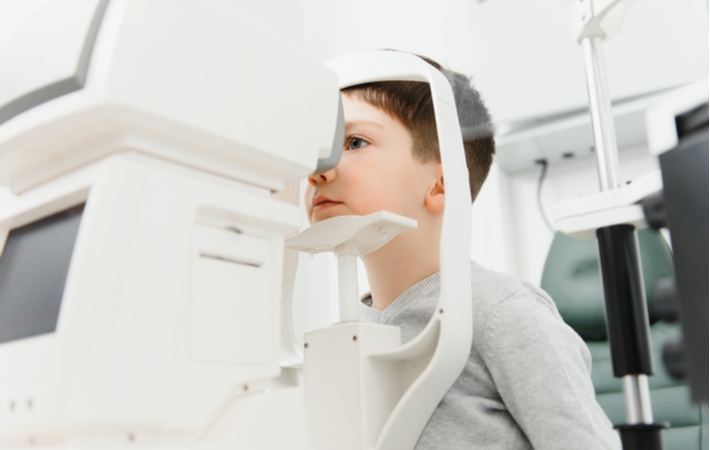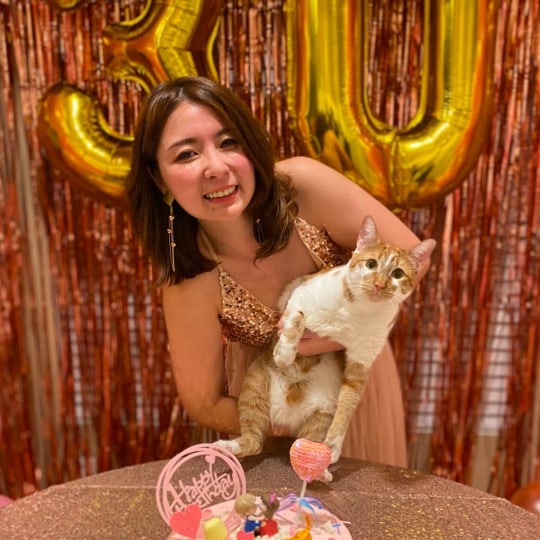Your Child’s First Visit to the Eye Doctor
Children use vision to learn about the world. Their eyes change quickly as they grow, and children may not know when their vision isn’t “normal.” The way they see the world is unique, so they may not be able to explain when they experience eye problems.
Children’s eye exams are more than an evaluation of their sight. Our friendly eye doctors in Scottsdale can recognize the signs of eye diseases and vision problems. We know how to make the conversation accessible and fun for kids of all ages. So when it’s time for their first eye exam, we have the tools to examine their eye health while keeping them comfortable.
When Should You Book a Children’s Eye Exam?
When you should book a child’s first eye exam, and any exam after that, depends on their age and risk level. The risk of eye problems, eye diseases, or health conditions can be affected by family history or environment. The first eye exam is crucial when determining if your child is at a higher risk of developing eye problems.
The American Optometric Association (AOA) recommends that a child’s first eye exam be between 6–12 months of age if they are a low-risk patient. After their first exam, children should have an eye exam:
- At least once between 3–5 years
- Once before beginning first grade
- Annually between 6–17 years
Children with a higher risk of vision or eye conditions should have an eye exam sooner and more frequently. Your child’s eye doctor can recommend how often your child should schedule regular visits.

Low Risk vs. High Risk
The risk level for vision and eye problems can be affected by multiple factors. People with a low risk generally have a personal history of healthy vision and no genetic history of eye problems. Higher risk can be a combination of family history, vision symptoms, health conditions, or environmental factors.
Some common conditions and factors indicating a higher risk of eye problems include:
- Amblyopia (lazy eye) or strabismus (crossed eyes)
- Anisometropia (eyes have unequal refractive powers)
- Academic performance problems
- Cortical visual impairment (CVI)
- Difficult or assisted labor (when associated with fetal distress)
- Eye injury or eye surgery
- Prematurity, low birth weight, or prolonged supplemental oxygen at birth
- Family history of eye conditions
- Health conditions with potential ocular manifestations
- High or progressive refractive error
- Infection of mother during pregnancy
- Known of suspected neurodevelopmental disorders
- Maternal smoking, alcohol, or illicit substance use during pregnancy
- Prescription or nonprescription drugs (or herbal remedies) with potential ocular side effects
First Eye Exam Age: Why Between 6–12 Months?
The American Optometric Association (AOA) guidelines are based on average vision development. Although their recommendations for eye exam frequency are general, they’re essential for understanding what to expect with your child’s vision.
In the first 4 months, infants begin to control eye movement. By 8 weeks, babies start focusing on faces, eventually learning to follow moving objects by 3 months. Yet, depth perception is developed at 5 months. A lot is going on, and most of it is related to how effectively children see rather than visual acuity.
There’s no harm in seeing your optometrist sooner or more frequently. However, optometrists use 6–12 months as a guideline because the average child has developed some control over their eye movement. Notably, some children meet certain developmental milestones earlier or later.
It may not be worrisome if a child has trouble with hand-eye coordination at 5 months, but it can be a problem if an eye turns in or out consistently. Only an eye doctor can assess your child’s vision to determine if their vision is healthy or if treatment is warranted.
Over 60% of the brain uses visual input. When children’s eyes and sight don’t function effectively, it can make learning more difficult. Early diagnosis and treatment can benefit their long-term eye health and prevent vision-related learning problems.
Signs of Vision & Eye Problems in Children
Vision and eye problems in infants are not common. Although there can be some wiggle room when they hit vision milestones, most babies experience few significant difficulties with visual abilities. However, signs and symptoms in children can sometimes be subtle, so it’s crucial parents are familiar with signs of potential problems.
Not all signs indicate a severe eye problem, but an eye exam can determine an appropriate treatment. Some signs parents should watch for include:
- Excessive tearing: When eyes produce frequent tears, it can indicate a blocked tear duct. It can also be a symptom of allergies, conjunctivitis (pink eye), or the common cold.
- Red or encrusted eyelids: Crusty, swollen, or red eyelids can be symptoms of an eye infection or blepharitis.
- Eye turning: In early development, some eye turning can be normal, as vision is still developing. However, when infants exhibit constant eye turning, it can indicate eye muscle control problems.
- Light sensitivity: Extreme sensitivity to light can indicate many eye problems, including elevated eye pressure.
- White pupil: Leukocoria is a condition where the usually black pupil is white. The white color may be only apparent in dark lighting conditions, when the child looks in a particular direction, or visible in photographs (white instead of red). Leukokoria is a sign of various eye conditions, including cataracts, retinal detachment, retinopathy of prematurity (ROP), or an eye tumor (retinoblastoma).
Contact your optometrist immediately if you notice any of these signs or have concerns about other observed eye issues. Early treatment for eye problems can help save sight.
Child’s First Eye Exam FAQs
Why Is It Important for a Child to Have an Eye Exam So Early?
Early eye exams are crucial to detect any vision problems that could affect a child’s development and learning. Young kids can’t always express their vision issues, or even know they have a vision issue, as they have no frame of reference for what “normal” may look like.
What Should I Expect during My Child’s First Eye Exam?
The exam will include tests to assess vision, eye alignment, hand-eye coordination, visual comprehension, tracking and teaming, and overall eye health. At Eye Lab, our eye doctors in Scottsdale make this process engaging (and non-invasive) for your little one.
What Can Happen If Vision Problems Are Not Detected Early in Children?
Undetected vision issues can lead to developmental delays, learning difficulties, and in some cases, permanent vision impairment.
What If There Is a Family History of Eye Problems?
If there is a family history of eye issues, it is especially important to adhere to the recommended eye exam schedule and inform the eye doctor about the family history.
Visit Us for Your Child’s First Eye Exam in Scottsdale
A child’s first eye exam is crucial for understanding their visual development. Whether your child seems to have healthy eyes or you have concerns, it’s never too early to contact us. Our friendly eye care team at Eye Lab can help make your child’s next visit comfortable.
Book an appointment for a children’s eye exam today!




